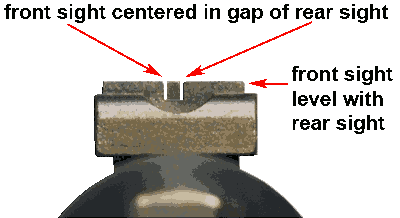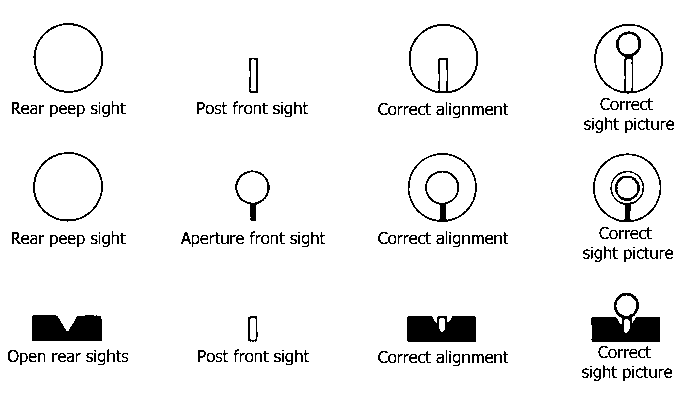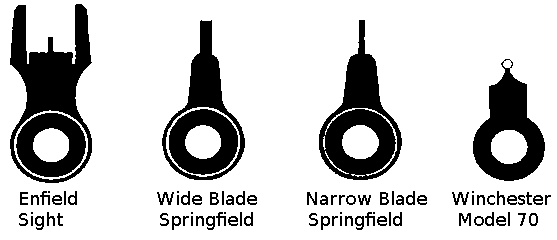Open Sights on Rifles
Terminology: Iron Sights, Open Sights, Peep Sight, Diopter, Aperture, Blade Sight, Jeager, Leaf, Folding Leaf, Tang Sight, Globe Sight, Windage Stem, Perlkorn, Ringkorn, Seilkorn,
Discussion on the types and variety of open sights
When discussing sight adjustment, some rifles have adjustable front sights, such as the AK-47, but most have adjustable rear sights. It is common for hunting and targeting rifles to have adjustable rear sights. Although that rifles like the aforementioned AK-47 have fixed rear sights, they do have elevation adjustments meant for field use which is a different matter altogether.
Contents
Sight Types
Common Commercial Hunting - The rear sight is known as a blade sight often on these types of firearms.

Illustration: Advantage of Open V Sight for Hunting Wild Game.
Although many iron sights on hunting rifles is completely flat, the shallow V style is becoming more popular. For hunting wild game you will find that the shallow V style rifle sight with a high contrast triangle will conceal less of the animal you are attempting to take down. The old fashioned buckhorn sight frequently found on 19th Century rifles tends to conceal two-thirds of the animal or more. Although Peep sights with shallow diopters can reveal much of the animal, target acquisition may be more difficult. Hunters tend to prefer the shallow V type sight.
Precision / Competition Shooting - Target aperture sights are designed for maximum precision. The rear sight element (often called diopter) is usually a large disk (up to 1 inch or 2.5 cm in diameter) with a small hole in the middle, and is placed close to the shooter's eye. Shooting diopters offer windage and elevation corrections. The complementing front sight element may be a simple bead or post, but is more often a globe type sight, which consists of a cylinder with a threaded cap, which allows differently shaped removable front sight elements to be used.
Unlike hunting rifles where the shooter generally has open iron sights, smallbore target rifles use what is known as "Aperture Sights". For an accurate shot with aperture sights the rear "aperture", "foresight element" and the "target diagram" must be aligned concentrically.
Aiming With Iron Sights
Open Iron Sights provide horizontal and vertical reference points that allow the shooter to train the weapon. With typical blade iron sights, the shooter should center the front post in the notch of the rear sight and the tops of both sights should be level. Since the eye is only capable of focusing on one plane, and the rear sight, front sight, and target are all in separate planes, only one of those three planes can be in focus. The front sight should be in focus.
Iron sights used by hunters are very useful when shots are made at shorter ranges and in heavy cover. The front sight at the end of the barrel is aligned with rear sight, located to rear of the barrel or above the action.

Illustration: Align the front sight level with the top of the rear sight over your target.
Your goal is to achieve what is known as the correct "Sight Picture."

Illustration: Correct Sight Picture Examples
There are a number of different types of iron sights. Each manufacturer's sight can have different methods of aligning Point of Aim (POA) and Point Of Impact (POI). Adjustable sights allow the individual users to adjust the sights to their preferences. Typical simple iron sight alignment centers the front post in the notch of the rear sight and the tops of both sights should be level with the desired POI.
Point Shooting
Point shooting can be thought of as the opposite of using your sights and therefore is mentioned here only for distinction. This is not a technique used for competition benchrest shooting or any match where there is plenty of time to aim at a fixed target. Point shooting is a technique where a shooter will quickly point the gun at the target and with both eyes open, line up the muzzle and fire. This technique was and still is taught to members of the military for use when there is no time for sighted fire, like in close quarter combat. This is also called indexing, target-focused shooting or instinctive shooting.
Point shooting is appropriate for certain types of competitions with moving targets or dynamic circumstances where time is a factor. It is also a technique for self defense shooting. There are many things that can factor into deciding to point shoot or use your sights. If there isn’t time, or there is a high probability that you will be shot if you take the time to line up your shot, this would be a good time to point shoot. Point shooting is something that all defensive shooters can learn and use. It is a more advanced technique, so it should only be attempted after you have a good basis of sighted shooting.
Adjusting Open Sights
All the adjustments should be made in very small increments and remembering the geometrical progression effect. Each time the adjustment is made, it has to be verified by a series of shots to check the proper adjustment.
Range adjustments are made for a fixed distance.
Field adjustments include compensations such as wind and elevation for distance.
You will initially sight in your rifle for a fixed distance in consideration for zero wind.
How to Sight in a Gun With Adjustable Diopter
You are moving the rear diopter in the direction you wish the bullet to go, which is opposite the direction to which it is off.
- If you are shooting high (elevation) lower the rear aperture.
- If you are shooting to the right, move the rear aperture left. (typically this is a counter-clockwise turn)
Military Iron Sights

Illustration: View of Classic Military Rifle Sight on Barrel